Improving hydrophilicity of polyester by surface electrospun deposition
LIU Shake,ZHANG Teng,LUO Chongyang, HUANG Leping,ZHAO Jinchao
(1.Hubei Biomass Fibers and Eco-dyeing & Finishing Key Laboratory, School of Chemistry and Chemical Engineering, Wuhan Textile University, Wuhan 430200, China;2.School of Material Science and Engineering, Wuhan Textile University, Wuhan 430200, China)
Abstract: In order to improve the hydrophilicity of polyester fabric, polyvinyl alcohol(PVA)/sodium alginate(SA) electrospun (E-spun) fibers was deposited directly on the surface of polyester fabric by electrospun method. The effects of polyvinyl alcohol concentration, sodium alginate concentration, volume ratio of polyvinyl alcohol and sodium alginate, and E-spun time on the morphology of E-spun fibers, modified polyester fabric(M-PET)′s hydrophilicity, antistatic property, air permeability and mechanical properties were discussed. The results show that when the PVA(10%)∶SA(2%)=9∶1, the E-spun fiber on the modified polyester fabric has uniform distribution morphology. The hydrophilicity and antistatic properties of modified polyester fabric increase considerably. Elongation at break and breaking force of the modified polyester fabric are enhanced,and its softness is maintained. Further increasing E-spun time has no obvious alterations in the mechanical properties. However, the formation of E-spun fiber layer lead to a significant decrease in the air permeability of modified polyester fabric .
Key words: polyvinyl alcohol; sodium alginate; modified polyester fabric; electrospun;hydrophilicity; antistatic property; air permeability; mechanical properties
0 Introduction
Polyethylene terephthalate(PET) commonly called as polyester is widely accepted as a textile material due to its excellent physical and chemical properties, such as excellent wash and wear, good dimensional stability, anti-wrinkle, and quick drying properties[1]. However, 100% PET has extremely poor moisture management property(0.42%) compared to cotton(8.5%)[2]. The poor water absorption and moisture retain of PET fabric make it less desirable material in many textile applications, such as sportswear, under garment, furniture, and bedding[3]. So improving hydrophilicity of PET is a focal point not only in the past but also in today.
The different method and technology had been performed to improve poor water absorption and moisture retain of PET fabric. There are three main methods: structural modification[4-7], chemical grafting[8-9]and hydrophilic agents finishing[10-11]. However, structural modification would resulted in the decrease of fiber strength; chemical grafting increased process complexity and chemical pollution; fabric comfort after hydrophilic agent finishing become poor[12].
Electrospun (E-spun) is a common technology of micro/nano fabrication. It has been developed since its introduction by Formhals in 1934[13]. Due to the high surface-to-volume ratio, E-spun fibers have been already applied in many difference areas[14], such as filtration[15], protective clothing[16], biomedical applications[17], battery electrode[18], reinforced composites[19]. Pirjo et al[15]produced lightweight coatings of polyamide-66 nanofibers by E-spun on different fibrous substrates. Discovered that a nanofiber layer on a fibrous substrate clearly improved the filtration efficiency of the substrate, even the lowest coating weight, had a clear effect on efficiency. Gibson et al[16]used E-spun to compose the elastomeric fibers membranes, which are under development for protective clothing applications. It was explored that E-spun fiber coatings produce an exceptionally lightweight multifunctional membrane for protective clothing applications, which exhibits high breathability, elasticity, and filtration efficiency.
In this study, polyvinyl alcohol(PVA)/sodium alginate(SA) E-spun fibers was deposited directly on the surface of PET fabric by electrospun method in order to improve the hydrophilic property of the PET fabric.
1 Experimental
1.1 Materials
Polyester fabric (75D×75D, 170T, 39.35 g/m2, knitted fabric) was used for the experiment. Polyvinyl alcohol (PVA,DP∶1 750±50, Alcholysis degree≥99%), and Sodium dodecyl sulfate(SDS) were purchased from Sinopharm Chemical Reagent Co. Ltd(China). Sodium alginate(SA, 660 cps) was supplied by Qingdao Bright Moon Seaweed Group Co. Ltd(China). All the reagents were dissolved with deionized water.
1.2 Preparation of E-spun solution
The PVA was swollen in deionized water at room temperature for 12 hours and then stirred, reflux condensation at 90 ℃ for 3 hours, the PVA solution was obtained. The SA was dissolved in deionized water at 60 ℃ for 3 hours to prepare the SA solution. Then, the PVA and SA were mixed with mechanical stirring, then adding SDS(0.111 5 g/50 mL). The concentration and mixed ratio of E-spun solution were shown in the Table 1.

Table 1 The concentration and mixed ratio of E-spun solution
1.3 Preparation of modified polyester fabric
The polyester fabric samples were cut into 40 cm × 17 cm and set on to the acceptor. The spinning polymer solution was placed into a 20 mL plastic syringe equipped with a needle with diameter 0.60 mm(20 G). A 20 kV DC voltage was applied across the electrostatic field, the distance between the needle tip and the collector was 20 cm, and the syringe pump was used to feed the polymer solution into needle tip and the feed rate of the syringe pump was fixed at 0.8 mL/h. The effect of E-spun time on the polyester fabric was discussed at 15, 20, 25, 30, 40 and 60 min. After E-spun fiber modification, the polyester fabric was removed from the collector and was dried under vacuum at 45℃ for 1 hour. The modified polyester fabric was obtained.The experimental setup used for the E-spun process is shown in Fig.1.
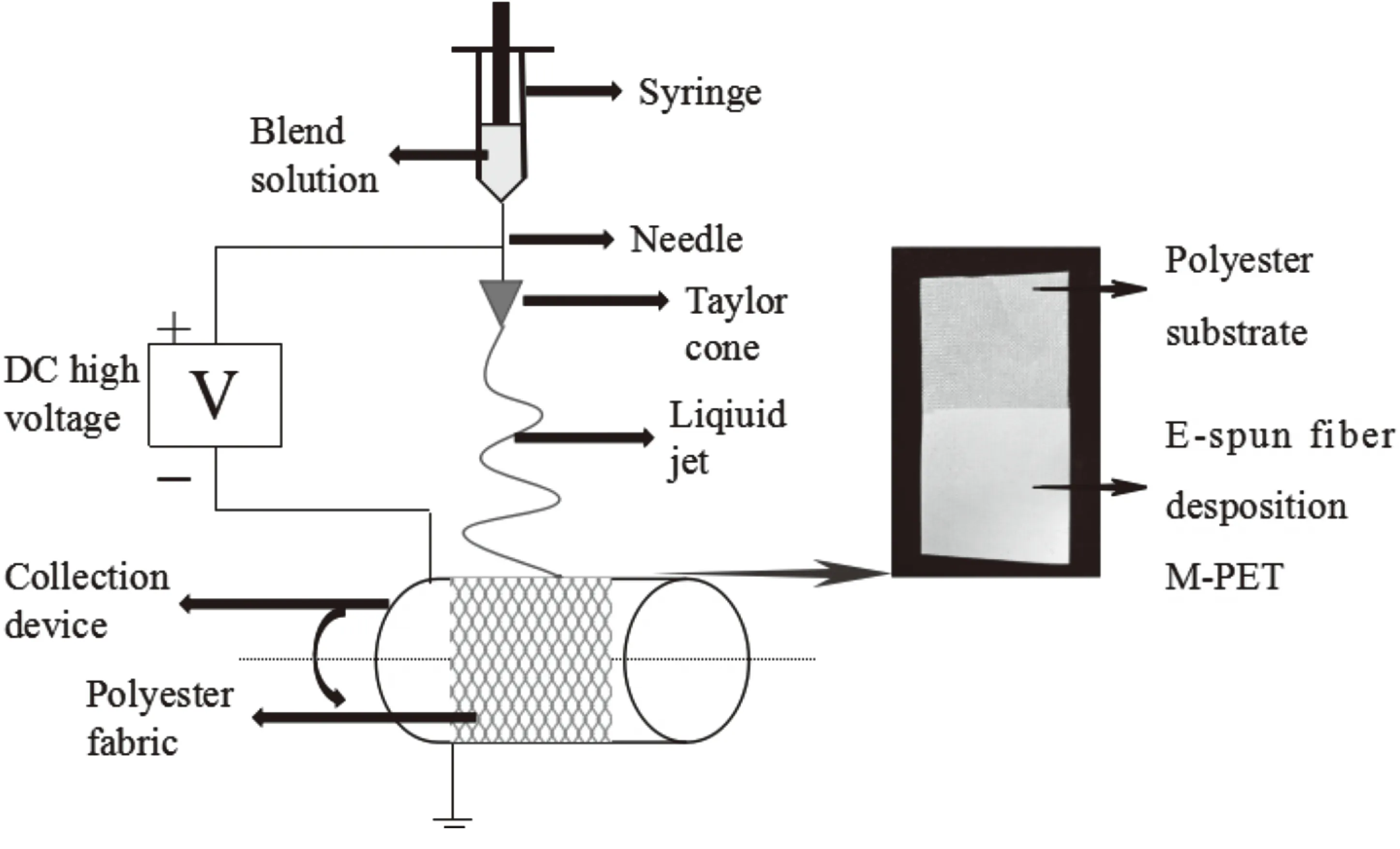
Fig.1 Experimental set-up of PET modified by E-spun method
2 Characterizations
2.1 Fabric weight test
The modified polyester fabric samples were cut into 15 cm × 5 cm. The reported results represent the average values from five samples.
2.2 Surface morphology
The morphology of modified polyester fabric samples was observed with scanning electron microscopy (PhenomTMDesktop Scanning Electron Microscope).
2.3 Hydrophilic properties test
The modified polyester fabric samples were cut into 30 cm × 5 cm(warp ×weft). Fix the tension folder at the bottom of the specimen(make the fabric no floating), draw a vertical line with a pencil in the tension folder along the warp. The other end of the specimen is fixed on the capillary effect instrument, and adjusted baseline coincides with the liquid level(1.5 g/L potassium dichromate solution). Record the height of the liquid along the warp for 30 minutes. Test two samples to take the average for the results.
2.4 Static friction test
FY403E fabric rubbing type electrometer(Wenzhou Fangyuan Instrument) was used for the static friction test. The friction voltage can be determined by the textiles rubbing again the friction cloth. The distance between the test probe and the sample is 15±0.1 mm. The standard size of the sample was 50 mm × 80 mm. The maximum friction voltage was obtained. The average voltage results represent from four samples.
2.5 Air permeability test
YG461E/Ⅱ Digital Air permeability Tester(Ningbo Textile Instrument Factory, China) was used for fabric air permeability test. According to the standard of the test is ISO 9237:1995, the reported results represent the average values from five samples.
2.6 Mechanical properties test
According to the standard of the test ASTM D5035∶1995, the H10K-L Series Materials Testing Machines(Tinius Olsen American) was applied to the test the breaking force and elongation at break of the samples. The standard of the sample is 20 cm × 5 cm(warp ×weft). The reported results represent the average values from five samples.
2.7 Softness
The modified polyester fabric samples were cut into 15 cm × 5 cm. FAST(Fabric assurance by simple testing) fabric style instrument was used to measure the bending length of the sample.
3 Result and discussion
The surface morphology of modified polyester fabric could be seen from the SEM image(Fig.2 to Fig.5,picture (b) is an enlarged view of picture (a) in each fig.), hydrophilic fibrous layer was deposited on the surface of polyester fabric by electro- spinning technique. Compared with the Fig.2(a) and Fig.3(a), the E-spun fiber on the polyester fabric had unevenly island-shape distributed morphology. With the increase of E-spun time, the E-spun fiber deposit on the polyester fabric surface became thicker. Compared with the high magnification of Fig.2(b) and Fig.3(b), the adhesion between the E-spun fibers and the beaded structure of fiber increased. Compared with Fig.2(a) and Fig.4(a), with the decrease of SA concentration, the morphology of E-spun fiber on the polyester fabric was more uniform dispersed. From the high magnification of the Fig.2(b) and Fig.4(b), the adhesion between the E-spun fibers and the beaded structure of fiber reduced obviously. Moreover, the diameter of the E-spun fiber increased. From the Fig.3(a) and Fig.4(a), with the volume increase of PVA(10%), the distributed of E-spun fiber on polyester fabric in the Fig.4(a) were more uniform and dense compared with that of in the Fig.3(a). There was not beadlike structure and the diameter of the E-spun fiber decreased in the Fig.4(b).

Fig.2 Surface morphology of sample at 20 min E-spun time (PVA(10%)∶SA(3%)=8∶2)

Fig.3 Surface morphology of sample at 40 min E-spun time (PVA(10%)∶SA(3%)=8∶2)

Fig.4 Surface morphology of sample at 20 min E-spun time (PVA(10%)∶SA(2%)=8∶2)

Fig.5 Surface morphology of sample at 20 min E-spun time (PVA(10%)∶SA(2%)=9∶1)
The weight of polyester fabric before and after modification was presented in the Table 2 and Fig.6, and the weight of polyester fabric after modification had a significant increase. As can be seen from the Table 2, as the concentration of PVA and SA increasing, the weight of the fabric had no obvious change. From Fig.6, as the E-spun time extended, the weight of the fabric increased.
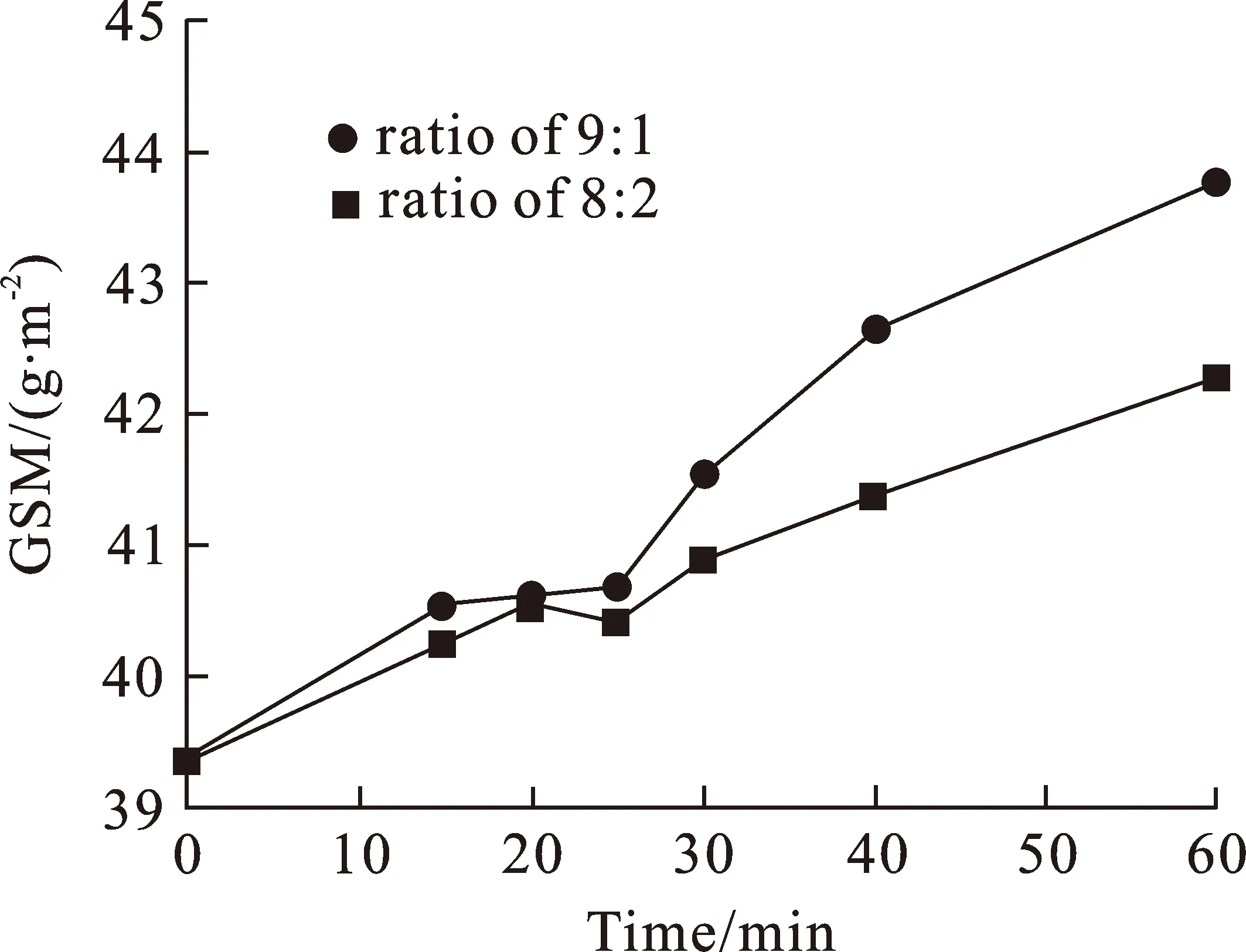
Fig.6 The weight of polyester fabric before and after modification at different E-spun times

Table 2 The weight of PET before and after modification at the 20 min E-spun time
Through GSM and the surface morphology analysis of polyester fabric, it was known that the fiber layer was successfully deposited on the surface of polyester fabric by electrospinning technology.
Fig.7 shows that the capillary effect value and electrostatic half-life of polyester fabric before and after modification.Fig.7(a) is the ratio of 9∶1,Fig.7(b) is the ratio of 8∶2.The hydrophilic properties of the fabric could be reflected by the capillary effect. Compared with the untreated polyester fabric, the capillary effect value of modified polyester fabric increased greatly, hydrophilic performance had been significantly improved. With the increase of SA concentration in the E-spun solution, the capillary effect value gradually increased, indicating that increasing the content of SA was beneficial to improve the hydrophilicity of modified polyester fabrics. It could be clearly seen from the Fig.7, compared with the untreated polyester fabric, the electrostatic half-life of modified polyester fabric was shorter, the antistatic properties of the fabric had been greatly improved. The addition of hydrophilic groups enhanced the hydrophilic properties of the fabric, led to faster diffusion of electrons on the surface of the fabric, electrostatic repulsion reduced during friction. When the concentration of mixed solution was PVA(8%)/SA(2%), the hydrophilic properties and antistatic properties of modified polyester fabric were the best.
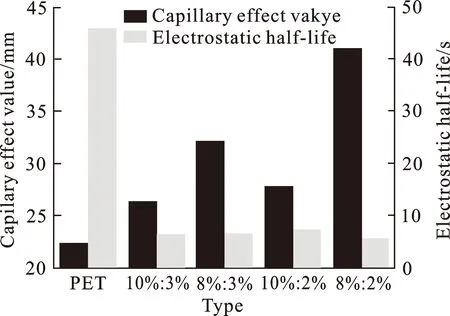
(a) ratio(v/v) of 9∶1
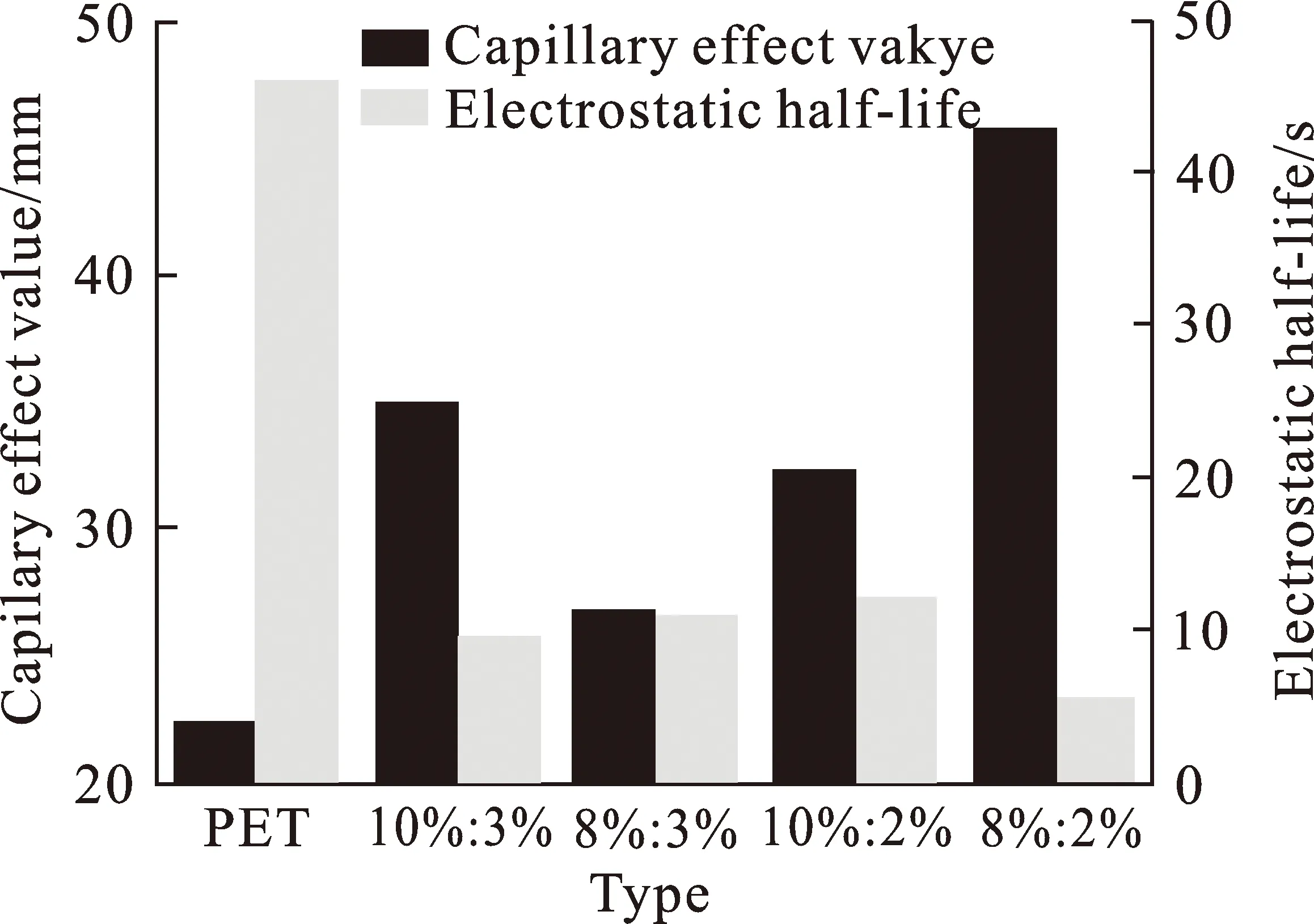
(b) ratio(v/v) of 8∶2Fig.7 The capillary effect value and electrostatic half-life of polyester fabric before and after modification
The air permeability of polyester fabric before and after modification at the same E-spun time was shown in the Table 3. With different concentration and different ratio of mixed solution, the air permeability of modified polyester fabric after spinning greatly reduced. When the PVA(8%)/SA(2%)=8∶2, the air permeability of modified polyester fabric was the highest. The air permeability of polyester fabric before and after modification at different E-spun times was shown in the Fig.8, with the increase of E-spun time, the air permeability of modified polyester fabric has a tendency to decrease, and at the ratio of 9∶1, the air permeability of modified polyester fabric was higher than the others.
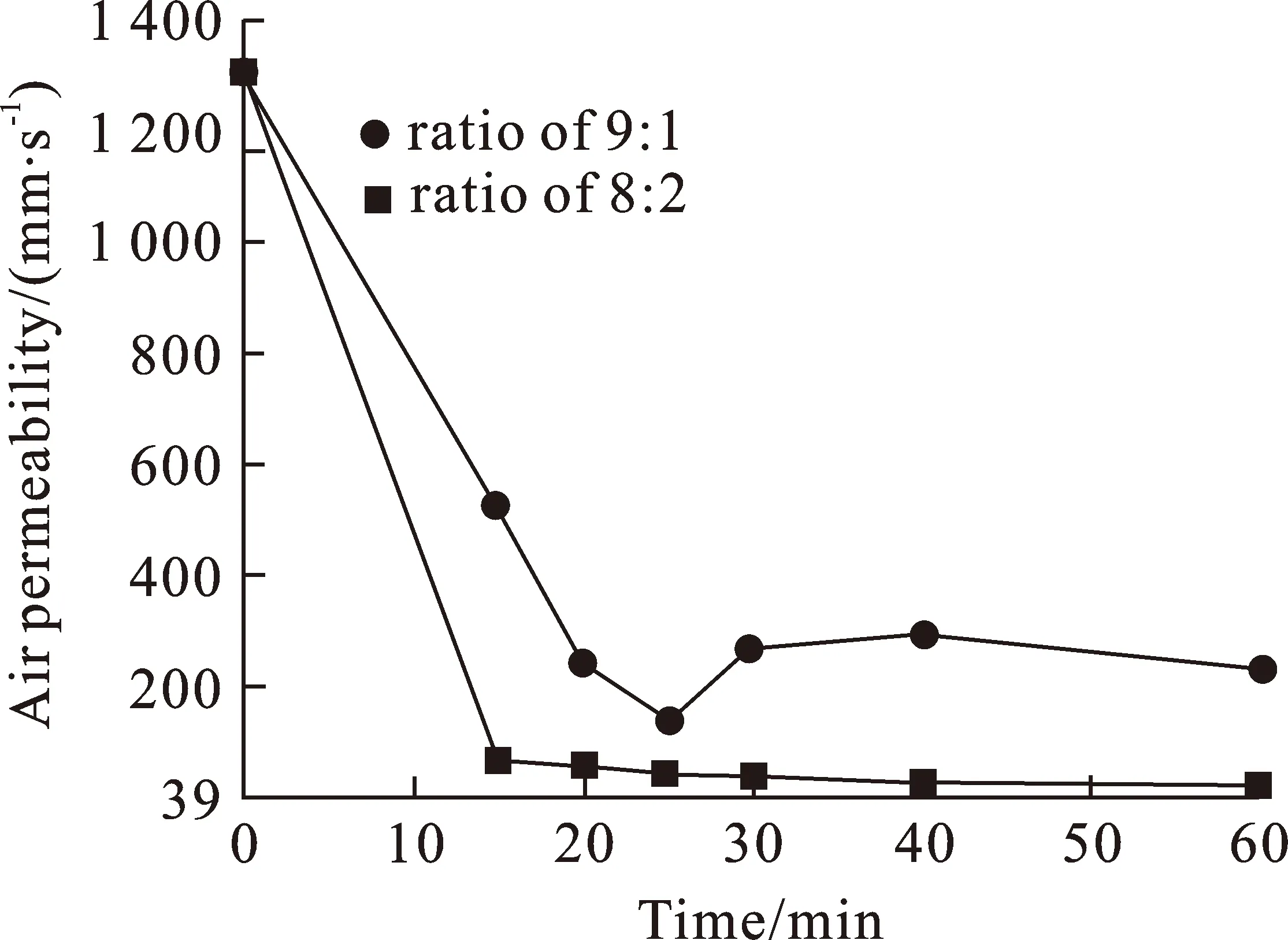
Fig.8 The air permeability of polyester fabric before and after modification at different E-spun times

Table 3 The air permeability of polyester fabric before and after modification at the 20 min E-spun time
The stress-strain curves of some sample were shown in Fig.9. Table 4 and Fig.10 showed the breaking force and elongation at break of the polyester fabric before and after modification at different conditions. Compared with untreated polyester fabric, the breaking force and elongation at break of modified polyester fabric had improved significantly. The PVA/SA fiber layer was deposited on the surface of the polyester fabric to form PVA/SA modified polyester fabric,and the fiber layer did not damage the structure of the polyester fabric during the deposition process.It was probable that the fiber layer had a certain strength which had good interface bonding with polyester matrix. Therefore, the mechanical properties of the modified polyester fabric were enhanced. From Table 4, when the ratio of PVA/SA was 8∶2, the breaking force and elongation at break of modified polyester fabric was larger than that of the ratio of 9∶1. And when the concentration of mixed solution was PVA(8%)∶SA(2%), the ratio of mixed solution was 8∶2, the breaking force and elongation at break of modified polyester fabric was the highest, 418.5 N and 19.52 respectively. From Fig.10, with the increase of E-spun time, the breaking force of modified polyester fabric was not continuously increase. Therefore, the increase of E-spun time did not have a significant effect on the breaking force of modified polyester fabric.

Fig.9 Stress-strain curves of polyester fabric Fig.10 Elongation at break and breaking force of before and after modification polyester fabric before and after modification at different E-spun times

IndexesUntreatedPVA(10%)∶SA(3%)9∶18∶2PVA(8%)∶SA(3%)9∶18∶2PVA(10%)∶SA(2%)9∶18∶2PVA(8%)∶SA(2%)9∶18∶2Breaking force/N260.0374.0396.0391.2395.2392.0398.4335.2418.5Elongation at break/%9.2315.7317.6518.6018.3318.6119.2315.4419.52
The softness is determined by the bending length of the fabric. The softness of polyester fabric before and after modification at the same E-spun time was shown in the Table 5. As can be seen from that, the bending length of polyester fabric after modification increased. The softness of modified polyester fabric deteriorated, but, not seriously. The softness of polyester fabric before and after modification at different E-spun times was shown in the Fig.11. With the increase of E-spun time, the bending length of modified polyester fabric increased, from about 9 to 14. So the softness of modified fabric decreased. So, the E-spun time should not be too long while hydrophilic properties of modified polyester fabric were enhanced.

Table 5 The softness of polyester fabric before and after modification at the 20 minute E-spun time
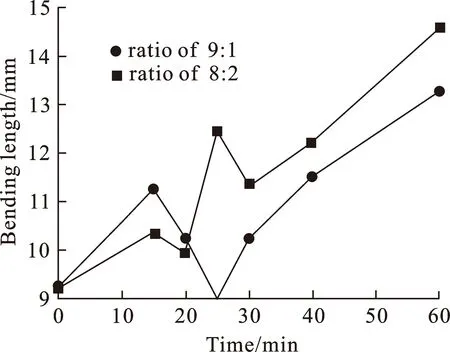
Fig.11 The softness of polyester fabric before and after modification at different E-spun times
4 Conclusion
The polyvinyl alcohol/sodium alginate nanofiber film was successfully deposited on the surface of polyester fabric by E-spun. During the study, polyvinyl alcohol concentration, sodium alginate concentration, volume ratio of polyvinyl alcohol and sodium alginate, and different E-spun time were studied to explore modified polyester fabric’s hydrophilicity, antistatic property, air permeability, mechanical properties.
The results show that,compared with untreated polyester fabric, the capillary effect value of modified polyester fabric increased, its hydrophilic properties were improved. Meanwhile, the antistatic properties of the fabric had been improved significantly. The mechanical properties of modified polyester fabric were better than those untreated, and modified polyester fabric retained softness. However, the air permeability of the modified polyester fabric was greatly reduced, which requires further exploration in subsequent experiments.
Acknowledgments:This work was supported by the National Natural Science Foundation of China (No.51303138)

